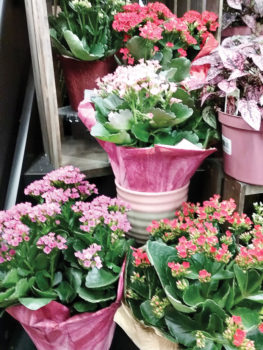
Kalanchoe blossfeldiana
How does your garden grow?
Louise Grabell, Pinal County Master Gardener
Outdoor gardening is over. Rest for the weary is not a bad thing. However, it is time to spruce up your home for the holidays. Everyone loves to decorate with those gorgeous poinsettias and I must admit the big box stores have been offering magnificent specimens. However, if you just want a sprinkle of color here and there with little attention needed, consider kalanchoe plants for your home. They come in almost every color you could imagine…except purple.
Kalanchoe blossfeldiana is a succulent plant usually grown inside. They are sold everywhere including the local supermarkets. When you buy them now, they are in full bloom and the flowers are very long-lasting. Around holiday time, you will find plenty of red and white specimens. The foliage is extremely attractive as the leaves are brilliant green and very glossy. A nice-sized kalanchoe in a six-inch pot will grow a foot tall.
Direct sun and hot window sills are no-noes for this succulent plant. Bright natural light is the key. Low light conditions cause kalanchoes to develop long spindly stems with buds that never open.
You can grow your kalanchoes outdoors from March ‘til November as long as they are never in direct sunlight, and the nighttime temperature is above freezing. Some outside locations provide sufficient protection that these plants can stay outside all year. Plan on placing your holiday plants outside in early spring for another season of blooms. Just 12-14 hours of nighttime next fall will trigger the bloom cycle once again.
As I mentioned, kalanchoes are succulents, which means they don’t like frequent watering. In fact, the more you forget about them, the better! They need good drainage and a deep, thorough soaking. Let the excess water drain away and you can probably wait two weeks before watering again. If your kalanchoe came in a foil-wrapped pot, remove the foil and make sure there is a drainage hole in the bottom.
A succulent and cactus mix with some regular potting soil makes a good medium for kalanchoes. Fertilizer can be applied annually in early spring. Kalanchoes are quite pest resistant. Weakened plants may succumb to aphids or mealybugs, so keep your eyes open for these insects. The leaves of kalanchoes are toxic to cats and dogs, so if your pet eats your houseplants, avoid kalanchoe…or train your pet!
Pinching back the spent flower stems keeps the plant more compact and encourages new flowering stems to grow. You can propagate new plants by carefully dividing the original plant clump into two or more divisions. Most store-bought kalanchoes actually have two or more plants per pot, so you will be able to separate them easily. It’s best to do any dividing in late spring after flowering is complete.
Your neighborhood Master Gardeners invite you to visit their website http://saddlebrookemastergardeners.org/ for all up-to-date information and events for your community. Garden questions? You can reach our very own Garden Helpline by calling Pat at 407-6459.
Remember, nothing brings more tranquility to the heart than a beautiful garden.
